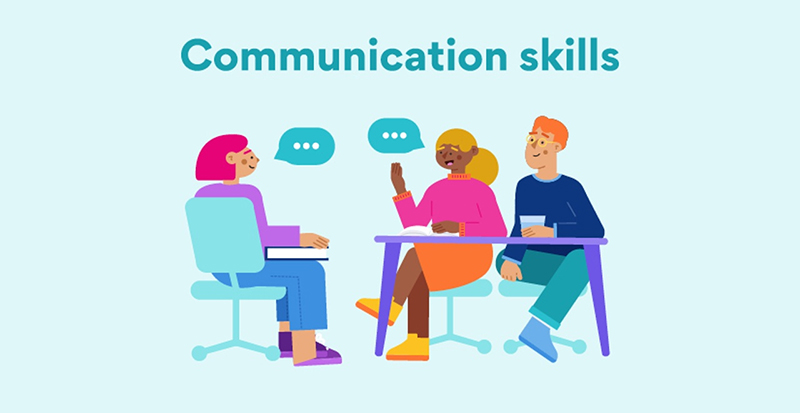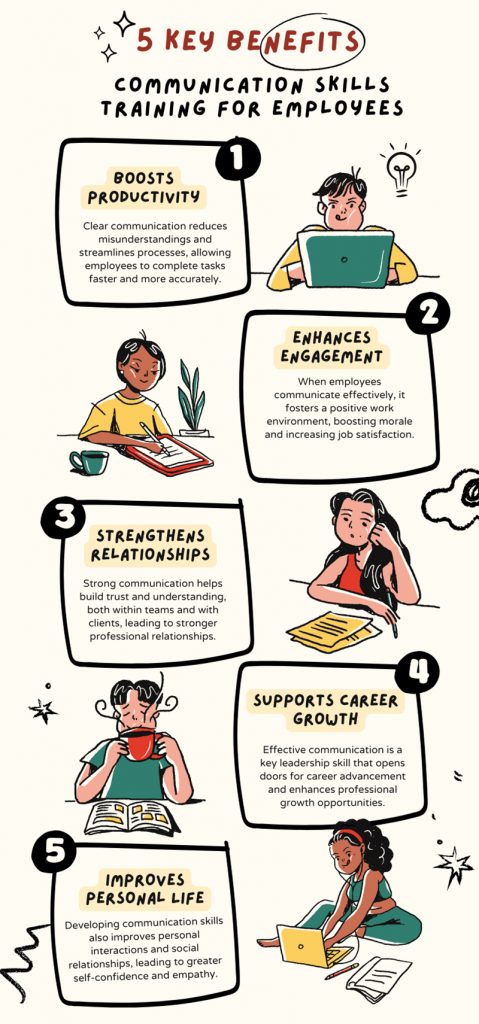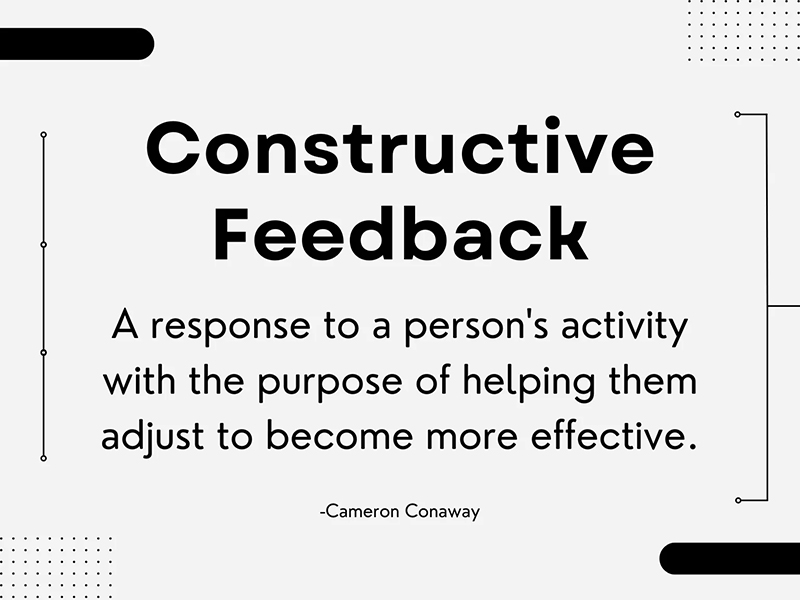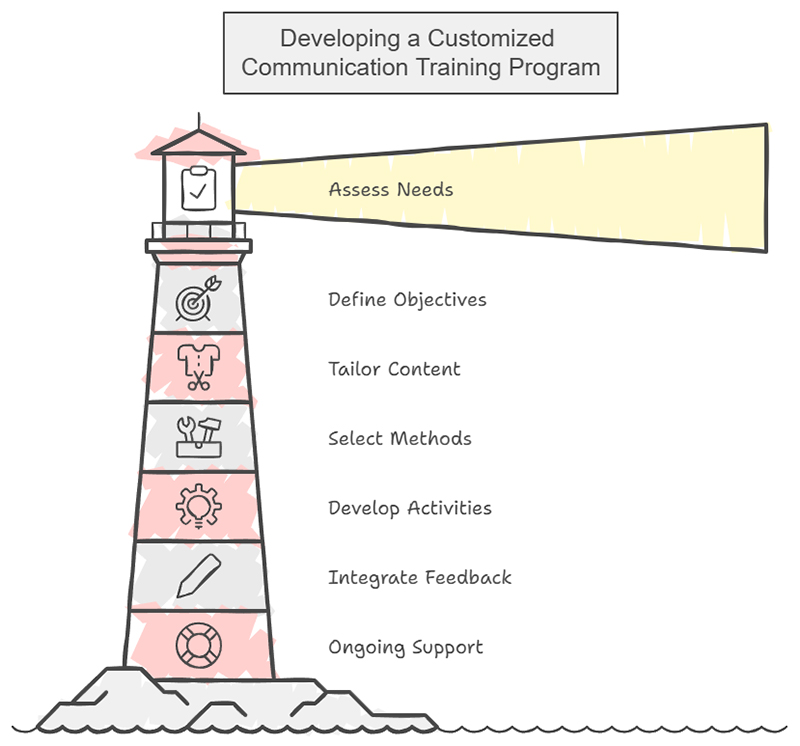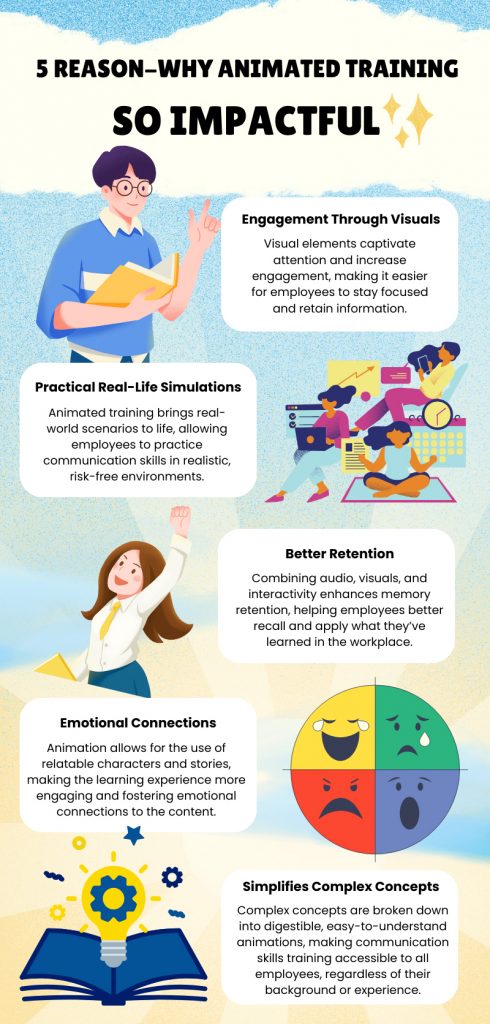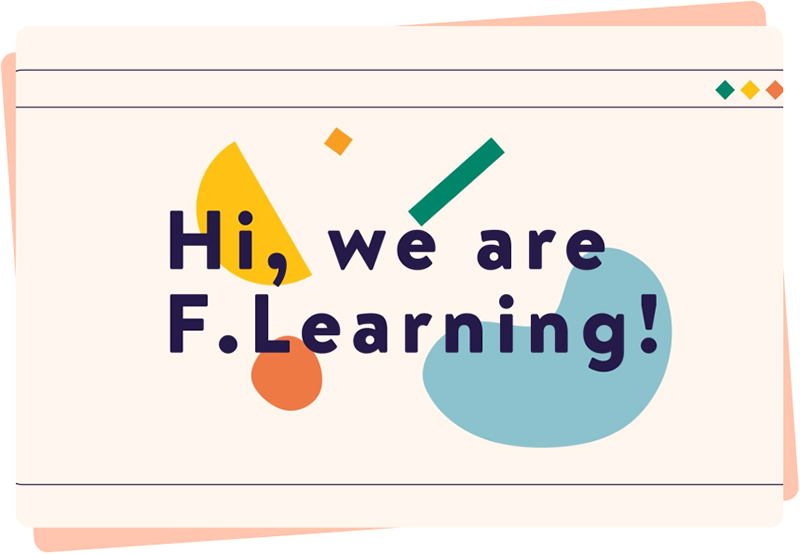Struggling with communication breakdowns, missed opportunities, and low team morale? Investing in communication skills training for employees could be the solution your organization needs to foster a more efficient and collaborative workplace. With the right training, your team can improve communication, build stronger relationships, and drive better business results.
In this article, you’ll uncover innovative training methods that make learning engaging, explore the 7 must-have skills every employee needs, and find the top 10 free courses to boost team communication. Plus, we’ll share 6 proven strategies to make your training programs impactful in 2025. Read on to unlock the power of effective communication!
- What is Communication Skills Training for Employees?
- Main Types of Communication in Corporate Settings
- 6 Key Communication Skills that Every Employee Needs
- Why Communication Skills Training for Employees is Essential
- 4 Different Methods of Business Communication Skills Training for Employees
- 6 Best Practices to Elevate Your Communication Training for Employees in 2025
- How to Develop a Customized Communication Training Program
- 10 Free Communication Training Online Courses for Employees in 2025
- Why Animated Communication Skills Training for Employees Are Effective
- Transform Your Communication Skills Training for Employees with F.Learning Studio Today!
- Conclusion
What is Communication Skills Training for Employees?
Communication skills training for employees is a structured approach to developing the skills needed for clear, effective corporate communication. This training, which can include communication seminars for employees, goes beyond basic speaking and writing; it equips employees with essential skills like active listening, non-verbal awareness, and adaptability to different communication styles.
With good communication training for employees, employees can prevent misunderstandings, resolve conflicts, and foster teamwork, creating a more productive and positive workplace. Such training not only enhances internal collaboration but also strengthens external interactions, ensuring that clients and partners experience clarity and professionalism in every exchange.

Main Types of Communication in Corporate Settings
To excel in workplace communication and drive skills enhancement, employees should be familiar with these 6 types of communication:

- Verbal Communication: Involves spoken interactions, such as face-to-face conversations, phone calls, and virtual meetings, key for clear, immediate information exchange in team discussions and negotiations.
- Non-Verbal Communication: Includes body language, facial expressions, gestures, and eye contact, which communicate emotions and intentions, reinforcing or contradicting verbal messages and influencing trust and engagement.
- Written Communication: Encompasses text-based communication like emails, reports, and memos, ensuring clarity and formalizing policies, instructions, and records within the workplace.
- Formal Communication: Follows official organizational channels, including meetings, reports, and performance reviews, ensuring clarity and documentation of policies and business decisions.
- Informal Communication: Includes casual, spontaneous conversations that foster camaraderie, encourage collaboration, and can spark creative ideas within teams.
- Internal and External Communication:
- Internal Communication connects employees and teams, aligning everyone with company goals and keeping them informed and engaged.
- External Communication focuses on maintaining relationships with clients, partners, and the public, strengthening the organization’s reputation and business relationships.
6 Key Communication Skills that Every Employee Needs
Understanding the key business communication skills for different types of interactions allows employees to navigate various situations confidently and professionally.
| No. | Communication Type | Key Communication Skill | Purpose and Importance |
| 1 | Verbal Communication | Clear and Concise Speaking | Essential for articulating ideas in meetings, phone calls, and presentations, helping ensure that messages are understood quickly and accurately. |
| 2 | Non-Verbal Communication | Reading and Using Body Language, Eye Contact, and Gestures | Non-verbal cues convey emotions and reinforce verbal messages. Mastering this skill builds trust and strengthens interpersonal relationships. |
| 3 | Written Communication | Writing Clear and Professional Emails, Reports, and Memos | Crucial for formalizing communication, maintaining clarity, and providing a permanent record. It enhances professionalism and avoids misunderstandings. |
| 4 | Formal Communication | Structuring Communication According to Organizational Protocols | Helps maintain professionalism and ensure clear, formal exchanges, such as performance reviews, official announcements, and reports. |
| 5 | Informal Communication | Engaging in Casual Conversations to Foster Team Collaboration | Encourages open dialogue, creativity, and stronger workplace bonds, contributing to a positive team culture. |
| 6 | Internal and External Communication | Tailoring Communication for Internal and External Stakeholders | Effective internal communication keeps teams aligned with company goals, while external communication builds relationships with clients and partners. |
Why Communication Skills Training for Employees is Essential
Effective communication training for employees is the backbone of any successful organization. Investing in soft skill development, particularly business communication training for employees, can have a profound impact on both individual performance and organizational success. Here’s how it benefits employees and the workplace:
4 Different Methods of Business Communication Skills Training for Employees
Selecting the right method for business communication skills training depends on the unique needs of your organization and its employees. Below is a breakdown of the most effective methods based on different organizational needs and goals.
1. Instructor-Led Training (ILT)
Instructor-led training remains a staple in many companies due to its interactive nature. This method is ideal for organizations that prefer face-to-face communication and direct engagement. It’s particularly effective for smaller teams or those who can gather in one location at a time. However, it can be challenging for large or international teams, especially with varying schedules or locations.
Best for: Small to mid-sized teams or companies with employees located in one area. It works well for in-depth discussions and hands-on practice but might require logistical planning for larger or distributed teams.
2. eLearning and Self-paced Modules
eLearning and self-paced modules offer flexibility and scalability, making it ideal for global organizations with employees scattered across different regions. It allows employees to complete training on their own time, which is particularly useful for multinational teams working across various time zones. Additionally, eLearning is great for periodic refreshers and ongoing skill development as employees can revisit content at their convenience.
Best for: International organizations or companies with remote teams. It’s an excellent choice when you need to track progress centrally, deliver standardized content, or fit training into employees’ varying schedules.

3. Interactive Simulations and Role-playing
Simulations and role-playing bring real-world scenarios into corporate training, allowing employees to practice communication skills in a risk-free environment. These methods are highly engaging and effective for training in customer service, conflict resolution, or negotiation. However, they can be resource-intensive in terms of setup and execution, especially for larger teams.
Best for: Teams that need hands-on practice in challenging communication situations, such as sales, customer service, or leadership. While great for skill-building, it works best in smaller, more focused groups to maximize the experience.

4. Animated Training Courses
Animated training courses offer a cutting-edge, highly engaging approach to communication skills training. They combine visuals, interactive elements, and audio to enhance understanding and retention. This method is particularly effective for employees who need to learn complex topics in a digestible, easy-to-understand format.
Animated courses can be taken anywhere, anytime, making them the perfect option for organizations looking to scale training without compromising engagement.
Best for: Companies looking for an efficient, engaging way to train large, distributed teams. Animated training is perfect for on-demand learning, quick refreshers, and scalable training across various departments. It’s also highly adaptable and can be customized for any type of business communication training.
interested to know more?
Glad you like us! Book a consultation call with us to explore how to kick start your animation project.
6 Best Practices to Elevate Your Communication Training for Employees in 2025
1. Use Realistic Role-Playing for Practice
- Description: Role-playing allows employees to practice real-life communication scenarios in a safe, controlled environment. This hands-on approach builds confidence and prepares employees to handle various workplace interactions.
- How to Do: Develop scenarios that reflect common workplace situations, such as handling customer complaints or resolving team conflicts. Assign roles to participants and encourage feedback from peers and trainers.
- Benefit: Helps employees refine their communication skills by practicing in realistic situations, leading to better preparedness and confidence in actual interactions.

2. Leverage Gamified Training Modules for Fun and Engagement
- Description: Gamified modules add an element of fun to learning by incorporating rewards, challenges, and progress tracking, making training more engaging and motivating.
- How to Do: Use gamification software or LMS features that allow for points, badges, or leaderboards. Design challenges that focus on key communication skills like active listening and assertive communication.
- Benefit: Increases engagement and retention, making it more likely that employees will actively participate and remember what they learn.

At F.Learning Studio, we offer tailored gamification solutions that focus on adding interactive elements without the need to build entire games. Our expertise in interactive learning, along with dedicated support and collaboration, makes us the ideal partner for companies looking to enhance their communication skills training programs for employees. Ready to transform your corporate training? Reach out TODAY!
3. Give Immediate, Constructive Feedback
- Description: Real-time feedback during training helps employees adjust their communication style immediately, reinforcing effective techniques and correcting mistakes.
- How to Do: Implement instant feedback tools, such as quizzes or quick surveys, to assess employee performance during training exercises. Trainers can also offer verbal feedback after role-play or interactive sessions.
- Benefit: Immediate feedback allows for quick improvement, ensuring that employees are aware of areas for development and can make adjustments right away.
4. Train for Cross-Cultural Communication
- Description: In today’s globalized workplace, understanding cross-cultural communication is essential. This practice teaches employees to communicate respectfully and effectively with colleagues from diverse backgrounds.
- How to Do: Foster empathy and perspective-taking by including case studies or role-play scenarios focused on cultural sensitivity. Teach employees about different communication norms and encourage open-mindedness and adaptability.
- Benefit: Fosters inclusivity and reduces the risk of miscommunication in diverse teams, creating a more harmonious and collaborative work environment.
5. Incorporate Digital Communication Etiquette Training
- Description: With the rise of remote work, digital communication etiquette is crucial. This training teaches employees proper email, messaging, and video call etiquette.
- How to Do: Offer modules on crafting concise emails, appropriate tone for messages, and best practices for virtual meetings. Include examples of both effective and ineffective digital communication.
- Benefit: Enhances professionalism in virtual interactions, reducing misunderstandings and helping employees communicate more effectively across digital channels.
6. Assess Progress Regularly
- Description: Regular assessments help track the effectiveness of communication training and identify areas where employees need more support.
- How to Do: Conduct periodic assessments through quizzes, surveys, or practical exercises. Compare results over time to see improvement and identify any skill gaps.
- Benefit: Provides clear insights into employee progress, helping managers refine training programs and allocate resources where needed.

How to Develop a Customized Communication Training Program
A one-size-fits-all approach to communication training may not address the specific needs of your organization. A customized program ensures that employees receive targeted training that aligns with their roles and responsibilities.
| Step | What To Do |
| 1. Assess Training Needs | Analyze your organization’s communication challenges. Gather feedback from employees and managers to identify specific areas for improvement (e.g., customer interactions, internal communication). |
| 2. Define Learning Objectives | Set clear and measurable goals for the program. Focus on key skills such as active listening, assertive communication, and conflict resolution. |
| 3. Tailor Content to Your Employees | Customize the training materials to match the employees’ roles and experience levels. Consider factors like team dynamics, job functions, and communication preferences. |
| 4. Select the Right Training Methods | Choose the appropriate delivery methods based on your employees. Options may include Instructor-Led Training (ILT), eLearning and Self-paced Modules, Interactive Simulations, and Role-playing or Animated Training Courses. |
| 5. Develop Engaging Activities | Create interactive and hands-on training activities such as role-playing, simulations, and case studies to keep employees engaged and actively practicing their skills. |
| 6. Integrate Feedback and Evaluation | Include regular assessments and feedback opportunities to track progress. Use quizzes, surveys, and performance reviews to measure improvement and adjust the program as needed. |
| 7. Provide Ongoing Support and Resources | Offer continuous learning opportunities, such as refresher courses or access to communication tools, to reinforce skills and support long-term growth. |
10 Free Communication Training Online Courses for Employees in 2025
In the modern, fast-moving workplace, online communication courses offer a convenient way for employees to develop essential skills without disrupting their schedules. These courses provide flexible learning options, allowing employees to enhance their communication abilities from anywhere, at any time.
Below is a list of the 10 free communication courses for employees that we gathered for your reference, helping your employees strengthen their business communication skills. Let’s take a look!
| No. | Course | Scope of Knowledge |
| 1 | Effective Communication | Covers core skills for clear and impactful communication in professional settings. |
| 2 | Communication in Project Management | Teaches strategies for effective communication within project teams to ensure clarity and goal alignment. |
| 3 | Communication and Interpersonal Skills at Work | Focuses on developing effective interpersonal skills to improve workplace relationships. |
| 4 | Group Communication, Teamwork, and Leadership | Explores communication techniques for teamwork, group dynamics, and leadership. |
| 5 | Retail Services – Communication | Tailored for retail employees, covering effective customer communication and handling service interactions. |
| 6 | Effective E-mail Communication | Teaches the principles of professional email communication, including clarity, tone, and conciseness. |
| 7 | Improving Communication Skills | Covers techniques to enhance both verbal and nonverbal communication skills in various situations. |
| 8 | Business Communications – The Basics | Provides a foundational overview of business communication principles, including verbal and written skills. |
| 9 | Winning With Communication – Master Your Communication Skills | Covers advanced communication strategies for persuasion, influence, and leadership. |
| 10 | Getting Your Voice Heard | Focuses on empowering employees to communicate assertively and ensure their ideas and opinions are acknowledged. |
Why Animated Communication Skills Training for Employees Are Effective
Animated communication skills training has become one of the most effective methods for developing key business skills. By combining visuals, interactivity, and storytelling, this method offers unique benefits, which are highlighted in the image below.
Transform Your Communication Skills Training for Employees with F.Learning Studio Today!
1. We Create Custom-Designed Training Content for Your Business Needs
F.Learning Studio transforms communication skills training with custom content tailored to your organization’s needs. We focus on engagement and retention, using visuals and interactive elements to create impactful, memorable learning experiences.
A prime example is how Guardian Group partnered with F.Learning Studio to transform dense HR strategy documents into engaging training videos. By condensing 20 pages of text into two concise 2-3 minute videos, F.Learning Studio delivered content tailored to employees’ needs. The use of culturally relevant animations and relatable scenarios boosted engagement, retention, and understanding of the new strategy. This customized approach helped Guardian Group simplify training, inspire employees, and ensure smooth implementation.
2. We Provide Engaging and Effective Animation with Various Types of Services
We excel in creating custom animations that simplify complex communication skills, making them more relatable and memorable for employees. Animated scenarios and character-driven storytelling keep learners engaged while reinforcing practical skills.
Our team offers a variety of engaging services tailored specifically for communication skills training for employees, designed to enhance understanding, retention, and participation.
- Learning Design: We develop structured, learner-centered course plans to ensure content flows logically and maintains engagement with real-world applications.
- Video Production: Our experts create high-quality videos that make communication strategies accessible and memorable for employees.
- Interactive Design: We incorporate quizzes, role-play simulations, and interactive activities that allow employees to apply communication skills in realistic scenarios.
- Graphic Design: We design visually compelling graphics that clarify key concepts, making it easier for employees to grasp and apply new skills.
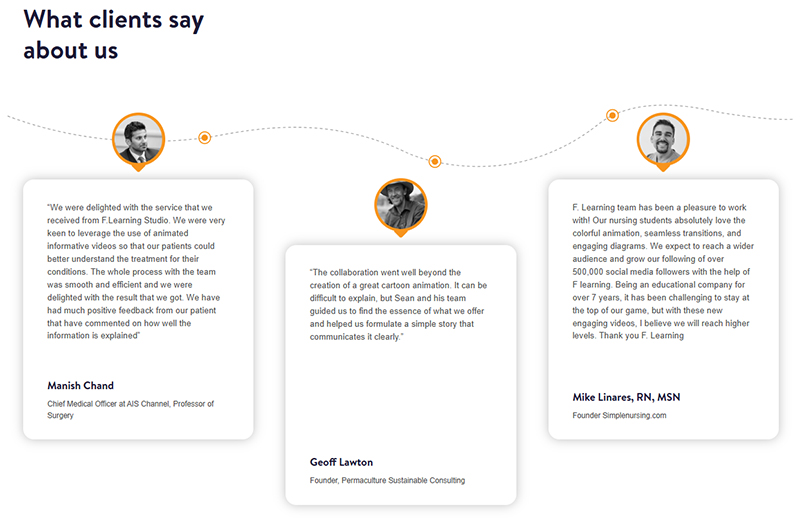
Additionally, we offer supportive services like free animation demos, free consultations, and content preparation to make your program development process smooth and cost-effective. With our comprehensive approach, we provide the tools needed to create effective, customized communication training that keeps employees engaged and motivated to improve their skills.
interested to know more?
Glad you like us! Book a consultation call with us to explore how to kick start your animation project.
Take Guardian Group as an outstanding example, a company that needed a creative way to bridge its new HR strategy and employee understanding, aiming to foster a more connected workforce. F.Learning Studio met this challenge by creating culturally resonant animations that transformed dense, 20-page documents into two short, captivating videos.
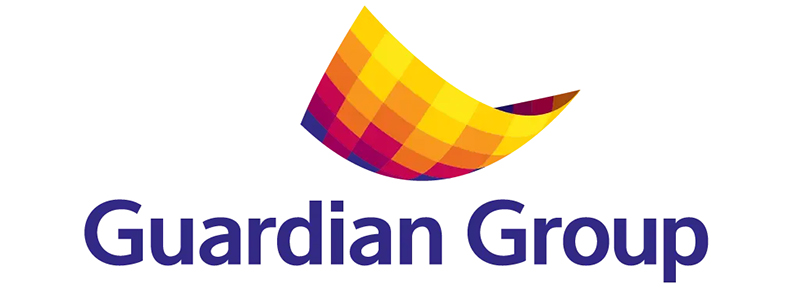
By using vibrant visuals and character designs aligned with the Caribbean audience, we helped simplify complex information and increase engagement. As a result, training time was reduced, retention improved, and implementation became smoother. This empowered employees to apply their newfound knowledge efficiently.
3. We Offer a Streamlined Process and Ongoing Support for Your Communication Skills Training Program
Our streamlined process ensures your communication skills training program is created efficiently and tailored to meet your unique needs. We simplify the production process, from concept to final delivery, handling every step with precision and transparency. Our team works closely with you to develop cost-effective solutions that maximize learning outcomes without exceeding your budget.
Additionally, our ongoing support keeps your communication skills training content updated, allowing it to adapt to evolving communication needs and maintain relevance for your team. This collaborative approach provides a hassle-free experience, giving you the convenience and confidence of a well-supported training program.
Conclusion
Communication skills training for employees is an investment in the future of your organization. This training has provided employees with the knowledge and skills to become more confident, persuasive, and influential communicators. As a result, your organization will experience increased productivity, improved morale, and enhanced customer satisfaction.
At F.Learning Studio, we are an ideal partner for creating tailor-made, interactive, and visually compelling training content that not only educates but also inspires action. Let us help you transform your communication training and empower your employees for success. Reach out to us today to get started on enhancing your team’s communication skills!
- Email: [email protected]
- Fanpage: https://www.facebook.com/f.learningstudio
- Website: https://flearningstudio.com/
- LinkedIn: https://www.linkedin.com/company/f-learning-studio/
Still not sure which is the best option for your current budget?

Sean Bui, the founder and creative director of F.Learning Studio, is a respected leader in the e-learning and multimedia production industry. With over 10 years of experience, he has dedicated his career to helping organizations create engaging and impactful learning experiences.
Under his leadership, F.Learning Studio has grown into a trusted partner for organizations in the education, healthcare, and corporate training sectors, producing over 2,000 minutes of educational animation.


